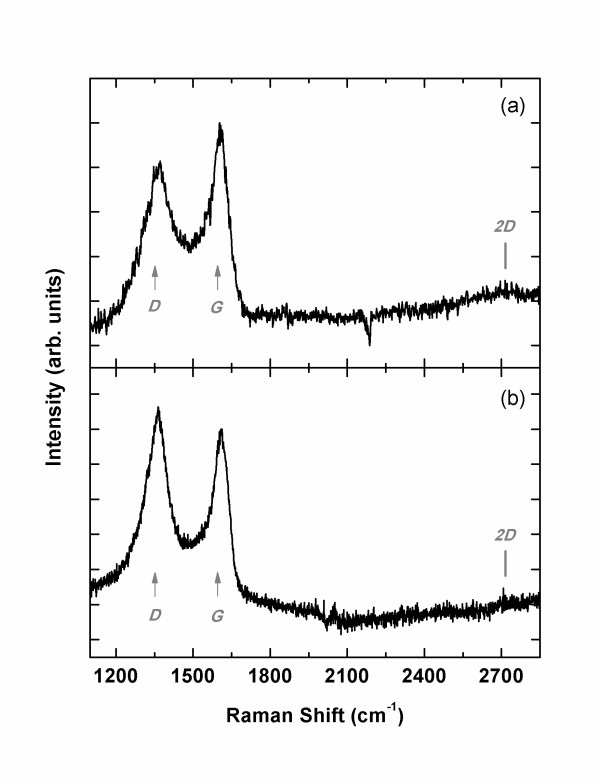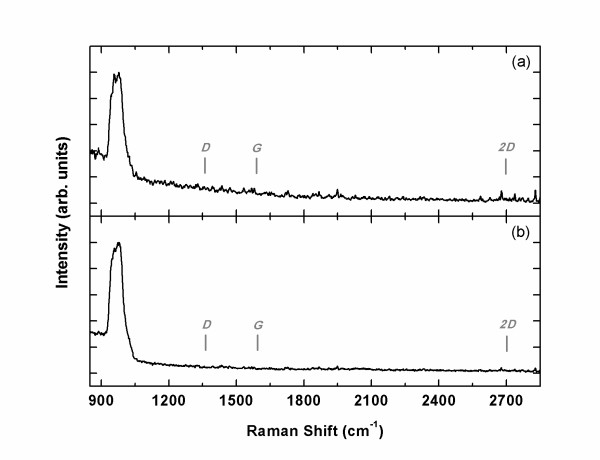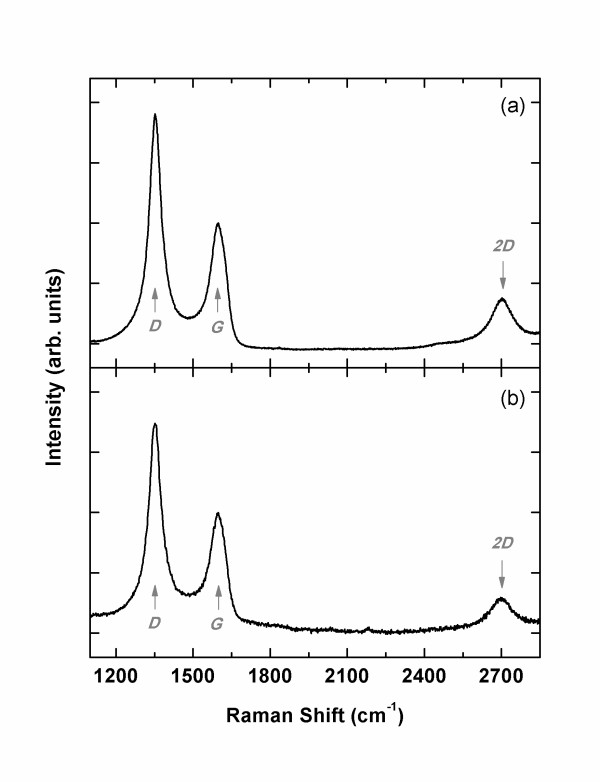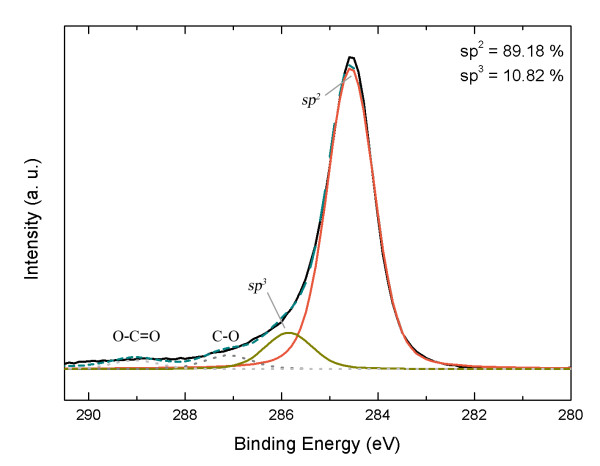Abstract
We report graphitic carbon growth on crystalline and amorphous oxide substrates by using carbon molecular beam epitaxy. The films are characterized by Raman spectroscopy and X-ray photoelectron spectroscopy. The formations of nanocrystalline graphite are observed on silicon dioxide and glass, while mainly sp2 amorphous carbons are formed on strontium titanate and yttria-stabilized zirconia. Interestingly, flat carbon layers with high degree of graphitization are formed even on amorphous oxides. Our results provide a progress toward direct graphene growth on oxide materials.
PACS: 81.05.uf; 81.15.Hi; 78.30.Ly.
Keywords: graphite, molecular beam epitaxy, Raman, oxide
Introduction
Graphene growth on Ni or Cu by chemical vapor deposition [CVD] is now well established. However, the CVD graphene needs to be transferred onto insulating substrates for application, which may degrade the quality and bring complications to the manufacturing process. This is why direct graphene growth on insulator is still intensively being studied. Notably, the growth on oxide is of great interest because graphene is expected to face current metal-oxide semiconductor [MOS] technology through an oxide layer. Recent studies have shown some accomplishments toward this goal by using CVD [1-3].
Here, we attempt molecular beam epitaxy [MBE] of carbon onto several oxide substrates to figure out the potential of graphene growth. So far, carbon MBE has been applied mostly on group IV semiconductors [4-7], where graphitic carbon growth was observed. We have shown previously that nanocrystalline graphite [NCG] can be formed on sapphire (Al2O3) and observed a Dirac-like peak for the first time in MBE-grown NCGs [8]. In this study, we expand the subject to include various crystalline and amorphous oxides. We observe that graphitic carbon or NCG can be grown by carbon MBE on amorphous SiO2, the most important oxide in the MOS technology. We also obtain similar results on glass (Eagle 2000™, Corning Inc., Corning, NY, USA). In contrast, carbons on amorphous TiO2 or Ta2O5 do not seem to form graphitic structures. Among the crystalline oxides, mainly sp2 amorphous carbons are observed on SrTiO3(100) and yttria-stabilized zirconia [YSZ] (100).
Methods
Materials and film fabrication
Samples were fabricated in a home-made ultra-high-vacuum MBE system. Carbons were sublimated from a heated pyrolytic graphite filament. The pressure of the chamber was kept below 1.0 × 10−7 Torr during the growth with the help of liquid nitrogen flowing in the shroud. Details about the growth procedure can be found elsewhere [8]. Both crystalline and amorphous oxide substrates were purchased from commercial vendors (AMS Korea, Inc., Sungnam, Gyeonggi-do, South Korea; INOSTEK Inc., Ansan-si, Gyeonggi-do, South Korea). The growth temperature (TG) was in the range of 900°C to approximately 1,000°C, based on our previous study with sapphire. The typical thickness of carbon film, determined by measuring the step height after lithography, was 3 to approximately 5 nm.
Characterization
Raman-scattering measurements were performed by using a McPherson model 207 monochromator with a 488-nm (2.54 eV) laser excitation source. The spectra recorded with a nitrogen-cooled charge-coupled device array detector. X-ray photoelectron spectroscopy [XPS] measurements to analyze carbon bonding characteristics were done by using a Kratos X-ray photoelectron spectrometer with Mg Kα X-ray source. C1s spectra were acquired at 150 W X-ray power with a pass energy of 20 eV and a resolution step of 0.1 eV. Atomic force microscopy [AFM] images were taken by a commercial system (NanoFocus Inc., Seoul, South Korea) in a non-contact mode.
Results and discussion
Raman-scattering measurements have become a powerful, non-destructive tool in the study of sp2 carbons (carbon nanotube, graphene, and graphite). The well-known G peak is observed in all sp2 systems near 1,600 cm-1. With the advent of graphene, the so-called 2D peak, which occurs near 2,700 cm-1, has become important. Single-layer graphene is characterized by the sharp and large 2D peak. This 2D peak is actually the second order of D peak. The typical position of D peak is 1,350 cm−1, one half of the 2D peak position. The D peak is absent in a perfect graphene sheet or graphite because of symmetry and increases as defects or disorders in the honeycomb structure increases. However, it should be noted that the D peak also disappears in amorphous carbon. That is, Raman D peak does indicate the presence of sixfold aromatic rings as well as sp2 bonds. It is from A1g symmetry phonons in which the D peak becomes Raman active by structural disorders in the graphene structure.
Ferrari and Robertson studied the degree of sp2 bonding and the relative strength of D and G peaks thoroughly [9-11], and recent experiments confirmed their theory [12,13]. Here, we follow their arguments and evaluate the degree of crystallinity based on the sharpness and the intensity of D, G, and 2D peaks. Let us start with carbon deposited on crystalline oxide substrates. Figure 1 shows the Raman spectra from the carbon films grown on SrTiO3(100) and YSZ(100). The well-developed D and G peaks with similar intensities indicate that the film consists of sp2 carbons with a number of defects. However, the 2D peak is hardly seen although a small bump is observed at the expected position in Figure 1a. According to recent criteria, the absence of a clear 2D peak implies the transition from NCG to mainly sp2 amorphous carbon [11]. Based on the intensity ratio, ID/IG ~ 1 (Table 1), we can conclude that the carbon films on SrTiO3(100) and YSZ(100) are in the middle of 'stage 2' as defined by Ferrari and Robertson [9].
Figure 1.
Raman spectra of carbon films. The films were grown (a) at 1,000°C on SrTiO3(100) and (b) at 900°C on YSZ(100). The D and the G peaks are identified.
Table 1.
Fitting results of the Raman spectra for various samples
| Substrate | Peak (D) (cm−1) | Peak (G) (cm−1) | ID/IG | I2D/IG | FWHM (G) (cm−1) | FWHM (2D) (cm−1) |
|---|---|---|---|---|---|---|
| SrTiO3 | 1,372 | 1,603 | 0.8 | - | 70 | - |
| YSZ | 1,364 | 1,609 | 1.1 | - | 63 | - |
| SiO2 | 1,352 | 1,598 | 1.9 | 0.4 | 66 | 96 |
| Glass | 1,352 | 1,598 | 1.8 | 0.3 | 66 | 99 |
Mixed Gaussian and Lorentzian functions are used to fit D, G, and 2D peaks. FWHM, full width at half maximum.
The crystalline ordering is worse than that of graphitic carbon grown at the same TG on a sapphire crystal, where a 2D peak is easily identified [8]. In the previous study, we observed that the crystal orientations of sapphire substrates did not affect the quality of NCG grown on them and speculated that the lattice constants and the substrate symmetry were not critical parameters in the NCG growth by MBE [8]. Then, we expect similar growth on cubic SrTiO3 and YSZ, contrary to what we observe. One possible explanation is that the optimum TG depends on the material. In fact, the Raman spectra in Figure 1 are similar to those of NCG on sapphire grown at 600°C, far lower than the optimum TG of 1,100°C [8]. Because of the difference in the sticking coefficient of carbon to the substrate and/or the diffusion constant of carbon on the surface, the optimum growth temperature may depend on the substrate. Further experiments of carbon growth on SrTiO3 or YSZ at different temperatures might prove this assumption.
Now, we turn to amorphous oxides, which are more relevant to the MOS technology. First, we tested 100-nm-thick TiO2 and Ta2O5 grown on SiO2(300 nm)/Si by sputtering. As shown in Figure 2, no sign of graphitic carbon is observed. The only peak near 1,000 cm−1 is the background Raman signal from Si wafer. Usually, this background is removed to highlight the carbon-related peaks, but we leave that in Figure 2 to show the absence of other peaks.
Figure 2.
Raman spectra of carbon films. The films were grown (a) at 900°C on amorphous TiO2 and (b) at 900°C on amorphous Ta2O5. No carbon-related peaks are observed. The peak near 1,000 cm−1 is from Si substrate.
The situation changes drastically as the substrate is changed to SiO2(300 nm) on Si wafer. Figure 3a shows that graphitic carbon of a relatively high degree of crystallinity is formed on SiO2. The Raman spectra are similar to the best data from NCG on sapphire [8]: the sharp and large D peak and the clear 2D peak. Notably, the existence of 2D peak is an important evidence of successful NCG growth on amorphous SiO2 [11]. This shows that the crystallinity of the substrate is not essential and explains why the quality of NCG was independent of substrate orientation in the previous study [8]. This surprising result may find interesting applications because we also expect a Dirac-like conduction in NCG [8]. Further optimization along with transport measurement is under progress. Similar results are obtained from Eagle 2000™ glass, a widely used material in active matrix liquid crystal displays (Figure 3b). This glass is known to consist of SiO2, B2O3, Al2O3, CaO, and Na2O. It means that SiO2 is not the only amorphous oxide on which graphitic carbon can be fabricated. Considering the variety of oxides, the quality of graphitic carbon can be improved much as the search for suitable substrates is continued.
Figure 3.
Raman spectra of carbon films. The films were grown (a) at 950°C on amorphous SiO2 and (b) at 900°C on Eagle 2000™ glass. In both cases, graphitic carbons of high crystallinity are fabricated.
Now that the carbon films grown on SiO2 and glass by MBE are identified as NCGs, it is informative to calculate the crystallite size from Ferrari and Robertson's model applied to stage 2 [9]. According to the model, the average size La is related to ID/IG as ID/IG = C La2, where C = 0.0055 and La in Å. From ID/IG = 1.8~1.9 (Table 1), we get La = 18.1~18.6 Å. In addition, the position of G peak at 1,598 cm−1 is in accordance with the identification of NCG of insignificant doping [9].
In order to clarify the carbon bonding nature, we performed XPS measurements on the graphitic carbon layer on SiO2. Figure 4 shows the C1s spectra, which are decomposed into several Lorentzian peaks. Here, we focus on the two strongest peaks centered at 284.6 eV and 285.8 eV. The relative intensity ratios are 89.18% (the peak at 284.6 eV) and 10.82% (the peak at 285.8 eV). In the literature, 284.7 ± 0.2 and 285.6 ± 0.2 eV components are attributed to sp2 and sp3 hybridization of C-C or C-H bonds, respectively [14]. In combination with the Raman spectra, the XPS results demonstrate that the sp2 bonds are dominant in the carbon layer on SiO2.
Figure 4.
C1s XPS spectra of graphitic carbon on SiO2. The dashed line is a fit with four Lorentzians. The two strongest peaks (centered at 284.6 eV and 285.8 eV) are assigned to sp2 and sp3 hybridized carbon atoms, respectively.
Another important result of this work is that the graphitic carbon on amorphous oxide is very flat, which is an important virtue for the integration with other materials. Figure 5 shows the AFM images of graphitic carbon on SiO2 and Eagle 2000™ glass. Like the NCG on sapphire, no sign of island growth is observed. The mean roughness parameters, Ra, from 1 μm × 1 μm scans are 0.224 nm (on SiO2) and 0.089 nm (on Eagle 2000™ glass). Notably, the Ra of NCG on Eagle 2000™ glass is almost the same as that of the substrate itself which is famous for surface flatness.
Figure 5.
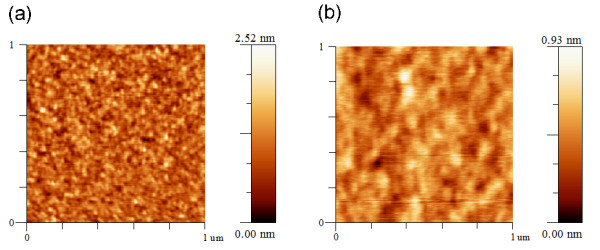
AFM images of graphitic carbon. 1 μm × 1 μm AFM images of graphitic carbon on (a) SiO2 and (b) Eagle 2000™ glass. The mean roughness parameters, Ra, from 1 μm × 1 μm scans are (a) 0.224 nm and (b) 0.089 nm, respectively.
Conclusions
In summary, we have grown graphitic carbon on crystalline and amorphous oxides by using carbon MBE. Notably, the graphitic carbons on amorphous SiO2 and on glass show a relatively high degree of graphitization, evidenced by well-developed D, G, and 2D Raman peaks. The C1s spectra from XPS measurements confirm the dominance of sp2 carbon bonding. In addition, the surfaces are almost as flat as the substrates, which may play an important role in the integration with the existing technology.
Abbreviations
AFM: atomic force microscopy; CVD: chemical vapor deposition; MOS: metal-oxide semiconductor; MBE: molecular beam epitaxy; NCG: nanocrystalline graphite; XPS: X-ray photoelectron spectroscopy; YSZ: yttria-stabilized zirconia.
Competing interests
The authors declare that they have no competing interests.
Authors' contributions
SKJ carried out the carbon molecular beam epitaxy experiments and X-ray photoelectron spectroscopy. DSY participated in the carbon molecular beam epitaxy experiments. JHL carried out the atomic force microscopy measurements. CK and SY characterized the thin films by Raman spectroscopy. SHC designed the experiments and wrote the manuscript. All authors read and approved the final manuscript.
Contributor Information
Sahng-Kyoon Jerng, Email: s.jerng@gmail.com.
Dong Seong Yu, Email: yds3927@naver.com.
Jae Hong Lee, Email: binggo120@naver.com.
Christine Kim, Email: maatcom@yahoo.com.
Seokhyun Yoon, Email: syoon@ewha.ac.kr.
Seung-Hyun Chun, Email: schun@sejong.ac.kr.
Acknowledgements
This research was supported by the Priority Research Centers Program (2011-0018395), the Basic Science Research Program (2011-0026292), and the Center for Topological Matter in POSTECH (2011-0030046) through the National Research Foundation of Korea (NRF) funded by the Ministry of Education, Science and Technology (MEST). This work was also supported in part by the General R/D Program of the Daegu Gyeongbuk Institute of Science and Technology (DGIST) (Convergence Technology with New Renewable Energy and Intelligent Robot).
References
- Su CY, Lu AY, Wu CY, Li YT, Liu KK, Zhang W, Lin SY, Juang ZY, Zhong YL, Chen FR, Li LJ. Direct formation of wafer scale graphene thin layers on insulating substrates by chemical vapor deposition. Nano Lett. 2011;11:3612–6. doi: 10.1021/nl201362n. [DOI] [PubMed] [Google Scholar]
- Scott A, Dianat A, Borrnert F, Bachmatiuk A, Zhang SS, Warner JH, Borowiak-Palen E, Knupfer M, Buchner B, Cuniberti G, Rummeli MH. The catalytic potential of high-kappa dielectrics for graphene formation. Appl Phys Lett. 2011;98:073110–1. doi: 10.1063/1.3556639. [DOI] [Google Scholar]
- Kidambi PR, Bayer BC, Weatherup RS, Ochs R, Ducati C, Szabó DV, Hofmann S. Hafnia nanoparticles - a model system for graphene growth on a dielectric. physica status solidi (RRL) - Rapid Research Letters. 2011;5:341–343. doi: 10.1002/pssr.201100155. [DOI] [Google Scholar]
- Hackley J, Ali D, DiPasquale J, Demaree JD, Richardson CJK. Graphitic carbon growth on Si(111) using solid source molecular beam epitaxy. Appl Phys Lett. 2009;95:133114. doi: 10.1063/1.3242029. [DOI] [Google Scholar]
- Al-Temimy A, Riedl C, Starke U. Low temperature growth of epitaxial graphene on SiC induced by carbon evaporation. Appl Phys Lett. 2009;95:231907. doi: 10.1063/1.3265916. [DOI] [Google Scholar]
- Maeda F, Hibino H. Thin graphitic structure formation on various substrates by gas-source molecular beam epitaxy using cracked ethanol. Jpn J Appl Phys. 2010;49:04DH13. doi: 10.1143/JJAP.49.04DH13. [DOI] [Google Scholar]
- Moreau E, Godey S, Ferrer FJ, Vignaud D, Wallart X, Avila J, Asensio MC, Bournel F, Gallet JJ. Graphene growth by molecular beam epitaxy on the carbon-face of SiC. Appl Phys Lett. 2010;97:241907. doi: 10.1063/1.3526720. [DOI] [Google Scholar]
- Jerng SK, Yu DS, Kim YS, Ryou J, Hong S, Kim C, Yoon S, Efetov DK, Kim P, Chun SH. Nanocrystalline graphite growth on sapphire by carbon molecular beam epitaxy. J Phys Chem C. 2011;115:4491–4494. doi: 10.1021/jp110650d. [DOI] [Google Scholar]
- Ferrari AC, Robertson J. Interpretation of Raman spectra of disordered and amorphous carbon. Phys Rev B. 2000;61:14095–14107. doi: 10.1103/PhysRevB.61.14095. [DOI] [Google Scholar]
- Ferrari AC, Robertson J. Resonant Raman spectroscopy of disordered, amorphous, and diamondlike carbon. Phys Rev B. 2001;64:075414. [Google Scholar]
- Ferrari AC. Raman spectroscopy of graphene and graphite: disorder, electron-phonon coupling, doping and nonadiabatic effects. Solid State Communications. 2007;143:47–57. doi: 10.1016/j.ssc.2007.03.052. [DOI] [Google Scholar]
- Cancado LG, Jorio A, Pimenta MA. Measuring the absolute Raman cross section of nanographites as a function of laser energy and crystallite size. Phys Rev B. 2007;76:064303. [Google Scholar]
- Teweldebrhan D, Balandin AA. Modification of graphene properties due to electron-beam irradiation. Appl Phys Lett. 2009;94:013101. doi: 10.1063/1.3062851. [DOI] [Google Scholar]
- Ermolieff A, Chabli A, Pierre F, Rolland G, Rouchon D, Vannuffel C, Vergnaud C, Baylet J, Semeria MN. XPS, Raman spectroscopy, X-ray diffraction, specular X-ray reflectivity, transmission electron microscopy and elastic recoil detection analysis of emissive carbon film characterization. Surf Interface Anal. 2001;31:185–190. doi: 10.1002/sia.955. [DOI] [Google Scholar]



